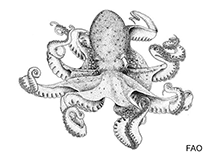Octopus incella Kaneko & Kubodera, 2007
Large-eared pikaGoogle image | No image available for this species;
drawing shows typical species in Octopodidae.
Classification / Names Populärnamn | synonymer | CoL | ITIS | WoRMS
Cephalopoda | Octopoda | Octopodidae
Environment: milieu / climate zone / djupintervall / distribution range Ekologi
. Subtropical
Distribution Länder | FAO områden | Ekosystem | Förekomster | Utplanteringar
Northwest Pacific: Japan.
Length at first maturity / Size / Weight / Age
Könsmognad: Lm ? range ? - ? cm Max length : 3.1 cm ML hane/ej könsbestämd; (Ref. 77097)
Life cycle and mating behavior Könsmognad | Reproduktion | Lek | Eggs | Fecundity | Larvae
Main reference
referenser | Koordinator | Medarbetare
Kaneko, N. and T. Kubodera 2007 A new intertidal octopus species, Octopus incella (Cephalopoda: Octopodidae), from Okinawa, southern Japan. Zootaxa 1140:39-49. (Ref. 77097)
IUCN Red List Status
(Ref. 130435: Version 2025-1)
CITES status (Ref. 108899)
CMS (Ref. 116361)
Threat to humans
Human uses
| FishSource |
Verktyg
Ytterligare information
Födosammansättning
Födointag
Predatorer
Max. ages / sizes
Length-weight rel.
Length-length rel.
Length-frequencies
Mass conversion
Abundans
Internet-källor
BHL | BOLD Systems | CISTI | DiscoverLife | FAO(Publication : search) | Fishipedia | GenBank (genome, nucleotide) | GloBI | Gomexsi | Google Books | Google Scholar | Google | PubMed | Tree of Life | Wikipedia (Go, sök) | Zoological Record



